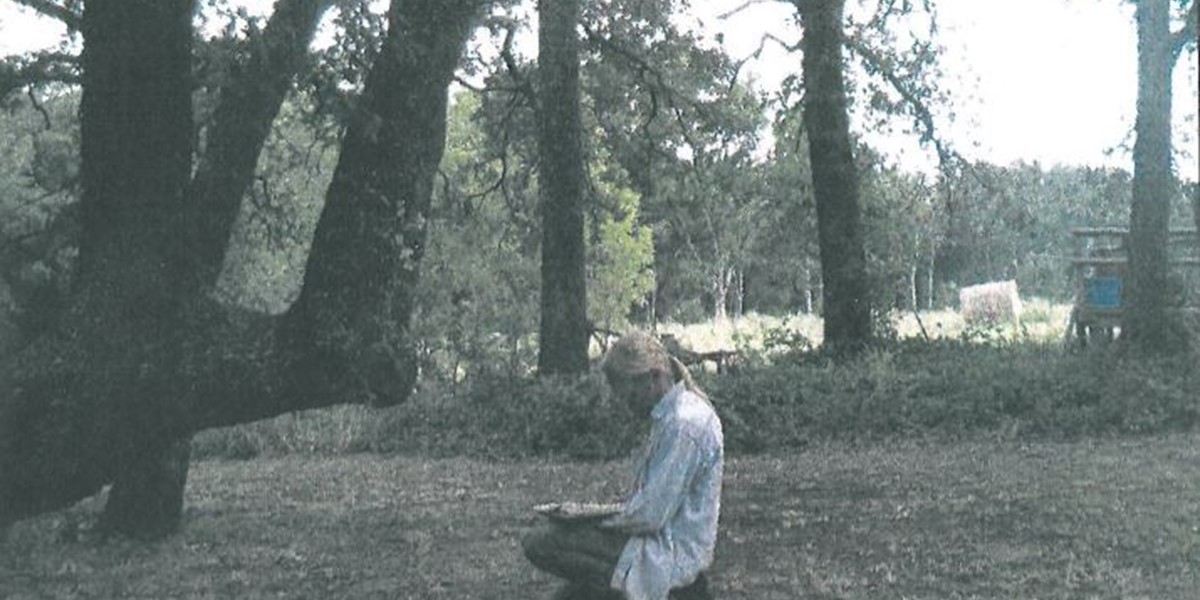
Certified Arborist Examines Gordonville Post Oak Tree

Arborist Steve Houser hard at work early Monday morning before the rain came, recording data regarding the Post Oak tree growing in the backyard of Gordonville resident Brad Ward. Photo by Brad Ward.

Published July 12, 2012 By JACQUITA LEWTER
Certified arborist Steve Houser traveled north from the metroplex into rural Grayson County Monday morning for an on-site visit in the backyard of Brad Ward. The object of the visit is the oddly shaped Post Oak tree growing on the Gordonville man's property which may be a historic Indian marker tree.
The tree in question is a Post Oak, approximately seven feet two inches in circumference at its base with limbs three to three and a half feet apart growing 30 to 36 inches off the ground. The base of the tree appears to have been bent and grows parallel to the ground supporting the limbs which grow upward.
Through family history records, Ward can trace the existence of the tree back over a hundred years. His late wife, Betty Moran Ward's father, Lloyd Moran, was born on this property in 1899. Ward recalled that his father-in-law told stories of playing around the tree when he was a young boy, seven to ten years old and that he picked up arrowheads at its base. He always thought the tree looked interesting but thought little else of it as the years went by.
Through a stroke of luck last spring while Ward was working at this computer, he clicked on a site which immediately got his interest. He was looking at a tree which looked a whole lot like the one in his backyard. Then he read a news release regarding an Indian marker tree located in Holliday, Texas. And that was the beginning.
Dr. Linda Peolon, an anthropology and history instructor at McLennan Community College in Waco, has researched Comanche Indian style marker trees for 15 years. According to Pelon, the strangely bent trees (tied down for years by Native Americans) typically pointed to low water crossings, campsites, rock paint quarries, hunting trails, graves, freshwater streams, and prayer sites.
Houser's visit this week to see WZard's tree is merely a step in the process. He made pictures of the tree from various angles, took measurements of the trunk and lower limbs, and calculated the tree's crown. He made notes concerning the type of soil in which the tree is growing. All documentation was carefully recorded.
"I've been doing this for 20 years," Houser said. "I always loved the outdoors as a kid and I loved trees." Houser serves as president of the Dallas Historic Tree Coalition. Their website is dhtc.org.
Houser volunteers his time to collect scientific data regarding the trees. "I always travel to the site," he said, "because you can tell so much more than by just looking at a picture." He commented that Ward's tree is really bigger than it appeared in the pictures he had seen previously.
Houser cautioned that all trees that have bent limbs are not Indian marker trees. "Sometimes nature can just cause a tree limb to grow at an odd angle," he said.
The age of a tree is also crucial. A bent tree will not grow at the same rate as a standing tree. Houser explained the various ways the age of a tree can be calculated. He said that a boring can be taken from the tree, but he personally declines to use this method, because..." if it is an Indian marker tree, then the tree is scared and you don't want to infringe on that."
Houser's role is to present the date and documentation he collects regarding a tree to the coalition of tribal elders. "Only the tribal elders can certify a tree as a marker tree," he said. He has met recently with tribal elders, and also works with the Language and Cultural Preservation Council. He holds the Native American in high regard and spoke frequently of respect.
To date, four Indian marker trees have been identified, authenticated and certified in Texas. Ward's enthusiasm for the project has sparked a good deal of interest in the local area. He is always eager to hear from others who either have such a tree or have seen a tree with bent limbs. Contact him at 27*** US Hwy 3**, Gordonville, Texas *****, or call 903-5**-****. Houser was scheduled to check out several other trees while he was in Grayson County on Monday.
NOTE: Mr. Brad Ward's contact information has been omitted as he has since passed away. We appreciate the time and effort Mr. Ward put forth into helping to identify potential Indian marker trees. He is missed.
